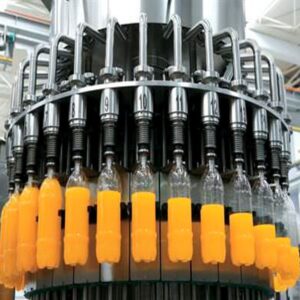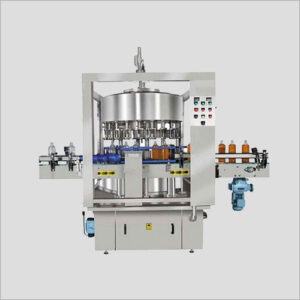Liquid Food Filling Equipment
Buy the best quality Liquid Food Filling Equipment online from Qualipak Machinery. We supply Liquid Food Filling Equipment around the globe including the United States, United Kingdom, UAE, Australia, Canada, Germany, France, and other European, Middle East, and Asia Pacific Countries.
Showing all 2 results
Understanding Liquid Food Filling Equipment
Liquid food filling equipment refers to specialized machinery designed for the precise and efficient packaging of liquid food products into various containers. These machines are a crucial component of the food and beverage industry, providing automated solutions to streamline the filling process and ensure product consistency. The primary objective of liquid food filling equipment is to accurately measure and dispense liquid products into containers, ranging from bottles and jars to pouches and other packaging formats.
Types of Liquid Food Filling Machines
Piston Fillers: These machines use a piston mechanism to accurately dispense liquid into containers. They are suitable for viscous products such as sauces, dressings, and creams.
Gravity Fillers: Gravity-based systems rely on the natural flow of liquid to fill containers. They are ideal for thin liquids like water, juices, and some beverages.
Volumetric Fillers: These machines measure the volume of liquid to be dispensed, ensuring precise filling. They are versatile and suitable for a wide range of liquid food products.
Overflow Fillers: Overflow fillers are used for foamy or carbonated liquids, preventing spills and maintaining accurate fill levels.
Time-Pressure Fillers: These machines use controlled pressure and time to fill containers accurately. They are suitable for a variety of liquid viscosities.
Components and Working Mechanism
Hoppers and Reservoirs: The storage units where liquid products are held before the filling process.
Conveyors: These systems transport containers to the filling station, ensuring a smooth and continuous production flow.
Filling Nozzles: The nozzles are responsible for accurately dispensing the liquid into containers. Different nozzles cater to various product viscosities and container types.
Control Systems: Advanced electronic controls regulate the filling process, ensuring precision, speed, and consistency.
Cleaning Systems: Hygiene is critical in the food industry. Liquid food filling equipment often includes automated cleaning systems to maintain sanitary conditions.
Benefits of Liquid Food Filling Equipment
Increased Efficiency
Speed and Throughput: Liquid filling machines significantly increase production speed, allowing businesses to meet growing demand and maximize output.
Precision and Accuracy: These machines provide consistent and precise fill levels, reducing product waste and ensuring uniform packaging.
Versatility
Adaptable to Various Products: Liquid food filling equipment can handle a wide range of liquid viscosities, allowing manufacturers to fill containers with products of different consistencies.
Container Flexibility: Whether bottles, jars, or pouches, liquid filling machines can be adjusted to accommodate various container types and sizes.
Cost Savings
Reduced Labor Costs: Automation minimizes the need for manual labor in the filling process, leading to cost savings and increased operational efficiency.
Minimized Product Waste: Accurate filling levels reduce product waste, contributing to overall cost-effectiveness.
Key Considerations for Businesses
Product Compatibility
Matching Equipment to Liquid Viscosity: Different filling machines are suitable for various liquid consistencies. Choosing the right equipment ensures optimal performance and product quality.
Temperature Sensitivity: Some liquids may be sensitive to temperature changes. It’s crucial to select filling equipment that can handle the required temperature conditions.
Production Volume
Scalability: Businesses should consider the scalability of liquid food filling equipment to accommodate future production growth.
Batch Sizes: Understanding the typical batch sizes is essential in choosing equipment that aligns with production requirements.
Cleanability and Hygiene
FDA Compliance: Ensure that the liquid food filling equipment meets Food and Drug Administration (FDA) standards and other relevant regulations to guarantee product safety.
Cleaning Protocols: Opt for machines with easy-to-clean components and automated cleaning systems to maintain high levels of hygiene.
Maintenance and Support
Equipment Reliability: Choose reputable suppliers that offer reliable and durable liquid filling machines, reducing the risk of downtime and maintenance issues.
Technical Support: Access to prompt technical support and maintenance services is crucial for minimizing disruptions in production.
Emerging Trends in Liquid Food Filling Equipment
Industry 4.0 Integration
Smart Sensors and Connectivity: Integration of smart sensors and IoT technologies enables real-time monitoring and data analysis for improved efficiency.
Predictive Maintenance: Predictive maintenance algorithms help anticipate potential equipment issues, reducing downtime and enhancing overall equipment effectiveness.
Sustainability
Eco-friendly Materials: Manufacturers are increasingly incorporating sustainable and recyclable materials in the construction of liquid food filling equipment.
Energy Efficiency: Energy-efficient designs and technologies contribute to reducing the environmental impact of liquid filling processes.
Sеlling Liquid Food Filling Equipment Linеs Globally
We are thrilled to extend our invitation to customers in the United States, where our cutting-edge filling machines are available across major cities such as New York, Los Angeles, Chicago, and Houston. Experience unparalleled efficiency and precision with our state-of-the-art solutions.
Our commitment to excellence also reaches the vibrant markets of Canada, offering our filling machines to cities like Toronto, Vancouver, and Montreal. Canadian businesses can now elevate their packaging processes with our advanced technologies.
Venturing into the Asia-Pacific (APAC) region, our filling machines are accessible in major countries like Japan, China, India, and Australia. Join numerous satisfied clients in enhancing your production capabilities with our reliable and versatile equipment.
In Europe, we are proud to serve businesses in influential countries such as Germany, France, Italy, and the United Kingdom. Elevate your packaging standards with our innovative solutions tailored to meet the diverse needs of the European market.
For our esteemed clients in the Gulf countries, our filling machines are available in key nations including Saudi Arabia, the United Arab Emirates, and Qatar. Transform your packaging operations with our high-performance machinery.
To our friends in Australia, experience the next level of packaging efficiency with our top-tier machines. We look forward to supporting businesses across the continent in achieving their production goals.
Thank you for considering our filling machines. Contact us today to explore how our solutions can revolutionize your packaging processes and drive your business towards unparalleled success.
Final Word
In conclusion, liquid food filling equipment plays a vital role in the food and beverage industry, offering enhanced efficiency, precision, and versatility. Businesses should carefully consider their product requirements, production volume, and hygiene standards when selecting the appropriate filling machines. With advancements in technology and a growing emphasis on sustainability, the future of liquid food filling equipment holds exciting possibilities for improved performance and environmental stewardship. As the industry evolves, staying informed about emerging trends and innovations will be crucial for businesses seeking to stay competitive and meet the evolving needs of consumers.
Frequently Asked Questions
1. What is liquid food filling equipment?
Liquid food filling equipment refers to specialized machinery designed for accurately dispensing and packaging liquid food products into containers. It ensures precision, efficiency, and consistency in the filling process.
2. What types of liquid food filling machines are available?
Liquid food filling machines come in various types, including piston fillers, gravity fillers, volumetric fillers, overflow fillers, and time-pressure fillers. Each type is suited for specific liquid viscosities and packaging requirements.
3. What are the key components of liquid food filling equipment?
Essential components include hoppers and reservoirs for liquid storage, conveyors for transporting containers, filling nozzles for accurate dispensing, control systems for automation, and cleaning systems to maintain hygiene.
4. What are the benefits of using liquid food filling equipment?
Liquid food filling equipment offers increased efficiency, versatility in handling various liquid viscosities, cost savings through reduced labor and minimized product waste, and adaptability to different container types.
5. How does liquid food filling equipment contribute to product quality?
Liquid food filling equipment ensures precise fill levels, reducing the risk of product waste and maintaining consistency. This contributes to high product quality and meets consumer expectations.
6. Is liquid food filling equipment suitable for different industries?
Yes, liquid food filling equipment is versatile and widely used across industries such as food and beverage, pharmaceuticals, dairy, and more. It can handle a diverse range of liquid products.
7. What considerations should businesses have when choosing liquid food filling equipment?
Businesses should consider factors such as product compatibility, production volume, cleanliness, and maintenance requirements. Understanding these factors ensures optimal equipment selection.
8. Are liquid food filling machines easy to clean?
Many liquid food filling machines come equipped with automated cleaning systems, making them easy to clean and maintain. This ensures compliance with hygiene standards in the food industry.
9. Can liquid food filling equipment be integrated with other production processes?
Yes, liquid food filling equipment can be integrated into existing production lines, offering seamless compatibility with other machinery and contributing to a more streamlined overall production process.
10. Are there emerging trends in liquid food filling equipment?
Yes, emerging trends include Industry 4.0 integration with smart sensors and connectivity, predictive maintenance for increased efficiency, and a growing emphasis on sustainability with eco-friendly materials and energy-efficient designs.


